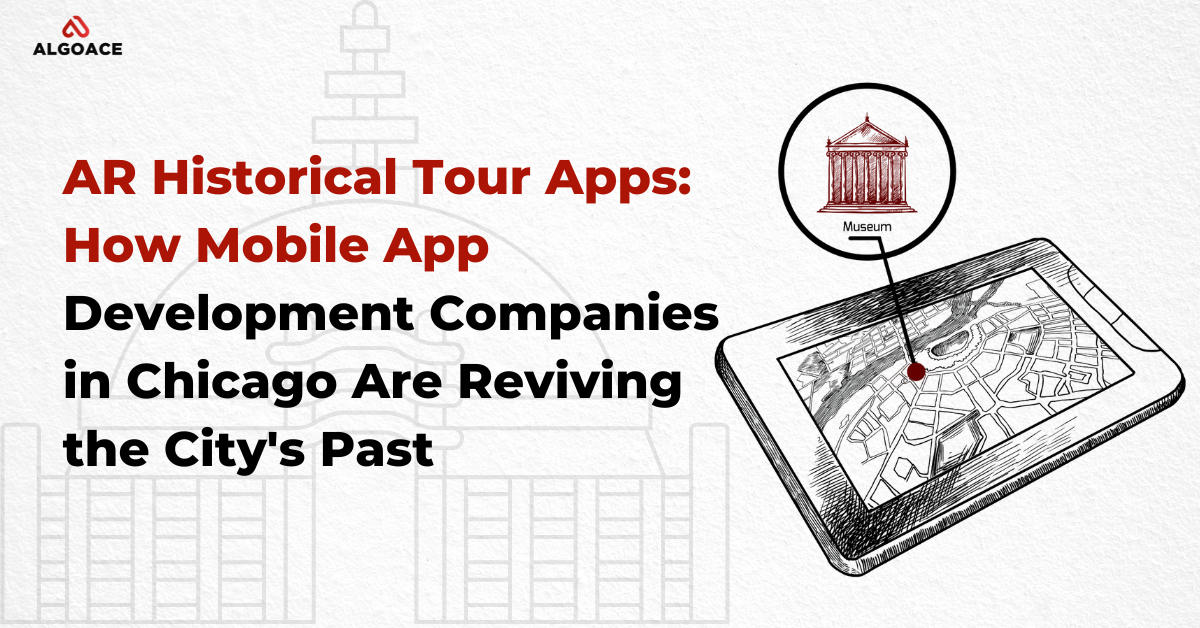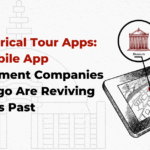
Chicago is a city filled with tales at every turn. From the vibrant 1920s and the Great Fire to architectural advancements and jazz legends, its past is lively—and now, it’s being experienced through your smartphone. With the help of mobile app development companies in Chicago, both locals and visitors can stroll through the Windy City and immerse themselves in its history with stunning augmented reality (AR).
What Are AR Historical Tour Apps?
AR historical tour apps are mobile platforms that merge real-world exploration with digitally superimposed historical information. By directing your phone at a landmark, you can view 3D reconstructions, historical figures, archival images, or even reenactments from decades or centuries past.
Picture yourself near the Chicago Water Tower, witnessing a dramatized depiction of the 1871 Great Chicago Fire unfold on your screen or spotting Al Capone sauntering by the Green Mill Cocktail Lounge. That’s the enchantment of AR, brought to life by software development companies.
Why Chicago Is the Perfect City for AR Tours
Chicago stands out as a city abundant in architecture, history, and culture, making it the perfect backdrop for engaging augmented reality (AR) tours. Its forward-thinking attitude and flourishing innovation landscape create an optimal space for mobile app developers to merge the past with the future through AR.
Contextual background and local relevance
Chicago is not just an ordinary city—it’s a dynamic museum. Its strong connections to American history, culture, and innovation position it as the perfect location for AR tour experiences, a field where specialized expertise, such as that offered by leading iOS app development services in Austin, becomes invaluable. Featuring architectural landmarks like the Willis Tower and Frank Lloyd Wright’s creations, to narratives of crime and jazz-age stories, the city presents endless tales to discover.
Mobile app development companies in Chicago have seized this remarkable opportunity. By fusing technology with storytelling, they are not only revitalizing tourism but also making the local history engaging and accessible for new generations.
How AR Enhances the Tourist Experience
Augmented Reality (AR) revolutionizes how visitors experience destinations by superimposing digital details onto the physical world. With features like interactive guides and vivid historical reenactments, AR enhances the travel experience, making it more captivating and educational.
Instant Immersion
AR offers an engaging experience that brings history to life. Instead of merely reading plaques or browsing Wikipedia, users can “witness” historical events taking place right where they originally occurred.
Accessibility for All
Whether you are an inquisitive traveler, a student, or a lifelong resident of Chicago, these applications enable exploration at your rhythm, in your chosen language, complete with audio narration or subtitles.
Self-Guided and Affordable
Say goodbye to pricey tour guides. AR historical tour applications are frequently free or low-cost, making the exploration of history more accessible to everyone.
What Features Are Powering These AR Apps?
Augmented Reality (AR) applications are transforming user interactions by integrating digital components with the physical world in real-time. These applications utilize sophisticated functionalities such as motion tracking, surface detection, and mapping of real-world environments.
Here’s what makes AR tour apps tick:
GPS + AR + AI = Smart Tours
Most applications rely on GPS to pinpoint your location. When you point your mobile device’s camera at a structure, AR superimposes a digital scene on your display, while AI personalizes your journey by providing information, trivia, or stories suited to your preferences.
3D Reconstructions and Holograms
Chicago’s history can now be experienced in three dimensions. Certain applications reveal how buildings appeared before renovations or even before they were destroyed by fire. You may also encounter holographic guides—such as a virtual historian or an old-fashioned newsboy—accompanying your tour.
Audio Tours with Real Voices
Narrations are frequently performed by actors employing local accents or historical tones to enhance realism. Some applications even recreate the soundscapes from different periods, allowing you to experience the jazz of the 1920s or the clattering of horse-drawn carriages.
Top AR Historical Tour Apps Built by Chicago Developers
Explore the premier AR historical tour applications developed by creative teams in Chicago, merging advanced technology with captivating narratives. These applications provide immersive exploration of the city’s history, rejuvenating past events in an unprecedented way.
1. ChiAR City Explorer
Created by a prominent mobile app development companies in Chicago, ChiAR City Explorer enables users to stroll through areas like Bronzeville, Hyde Park, and the Loop while viewing historical overlays and listening to firsthand accounts from long-time residents.
2. Ghosts of the Chicago River
This eerie yet educational app fuses AR technology with folklore. As you walk along the Chicago Riverwalk, you will discover ghost tales and enigmas linked to the river’s industrial history. Developed by a local software development team, it seamlessly combines local legends with historical facts.
3. Capone’s Chicago
This AR application invites you on a gangster-themed journey through the Prohibition era. From clandestine speakeasies to notorious mobster hideouts, the app employs gamification and AR re-enactments to maintain user engagement. Imagine it as “Chicago’s Mafia History meets Pokémon Go.”
The Role of Mobile App Development Companies in Chicago
The development of AR tour applications relies heavily on the expertise of talented developers. Mobile app development companies in Chicago are at the forefront of this trend because of their unique insight into the city’s history, neighborhoods, and tourist attractions.
The Mobile App Development Company in Qatar and others like it skillfully combine local insights with state-of-the-art technology. They utilize tools like Unity, ARKit (for iOS), ARCore (for Android), machine learning models for historical image recognition, and geo-location APIs to provide fluid, real-time augmented reality experiences.
Collaboration with Museums and Historians
Partnering with museums and historians enhances projects by integrating genuine knowledge and exclusive archival resources. This collaboration guarantees historical precision and vividly brings engaging narratives to life.
Authentic Storytelling
To transform these applications into something beyond just impressive technology, software development companies frequently collaborate with museums, universities, and historical organizations. This partnership guarantees that the content is not only accurate but also profoundly informative.
For instance, developers might team up with the Chicago History Museum or researchers from the University of Chicago to confirm historical timelines and gather rare photographs or stories.
Community Voices Matter
Some AR applications are even developed in conjunction with community members to amplify the narratives of underrepresented neighborhoods, such as Pilsen, Englewood, or Little Village. This inclusive strategy makes the applications more relatable and meaningful to a wider audience.
Impact on Tourism and Education
AR historical applications have initiated a fresh trend in “edutourism,” which focuses on learning and involvement through travel.
Boosting Local Businesses
Numerous AR applications suggest stops at cafés, bookstores, or gift shops related to the storyline. This encourages increased visitor numbers to local enterprises and contributes to the economic development in historic areas.
Enriching School Field Trips
Teachers are incorporating these apps into their field trip programs. Rather than merely reading about the Great Chicago Fire, students can experience it in AR while strolling through the city. This is transformative for experiential education.
Challenges and Future Improvements
Engaging with cutting-edge technology often brings substantial challenges, ranging from technical difficulties to changing user expectations. Surmounting these obstacles promotes ongoing innovation, guiding future enhancements and advancements.
Tech Barriers
Not every user has access to high-end smartphones, and AR applications can quickly drain battery life. Developers are striving to create more efficient and accessible versions to appeal to a wider audience.
Content Gaps
Certain neighborhoods and historical periods remain underrepresented. As mobile app development companies in Chicago form more collaborations with local historians, it’s hoped this disparity will be addressed.
Future of Wearables
As AR glasses gain popularity, the usage of these apps might transition from mobile phones to wearable devices. Picture navigating Michigan Avenue with historical events visualized directly in your smart glasses—hands-free and even more engaging.
Why Businesses Should Pay Attention
If you own a museum, cultural institution, or hotel, now is the ideal time to partner with software development companies to craft tailored AR experiences. These applications present powerful opportunities for engaging customers, drawing in tourists, and memorably sharing your narrative.
Given Chicago’s reputation as a technology-centric city, opportunities are expanding swiftly. Whether it’s a minor AR feature or a comprehensive interactive map, the potential for business and community influence is vast.
Conclusion
Due to the creativity and innovation of mobile app development companies in Chicago, both residents and tourists can now engage with the city in a completely different manner. These AR historical tour applications are more than just digital curiosities—they serve as connections between the past and present, as well as between communities and their stories.
Chicago is sharing its narrative in unprecedented ways, and the future of tourism and education appears to be more interactive, inclusive, and inspiring.
So the next time you wander along Wacker Drive or explore Navy Pier, don’t just observe—scan. You may encounter a ghost, see a lost building, or enjoy a jazz band from the 1930s.





0 Comments